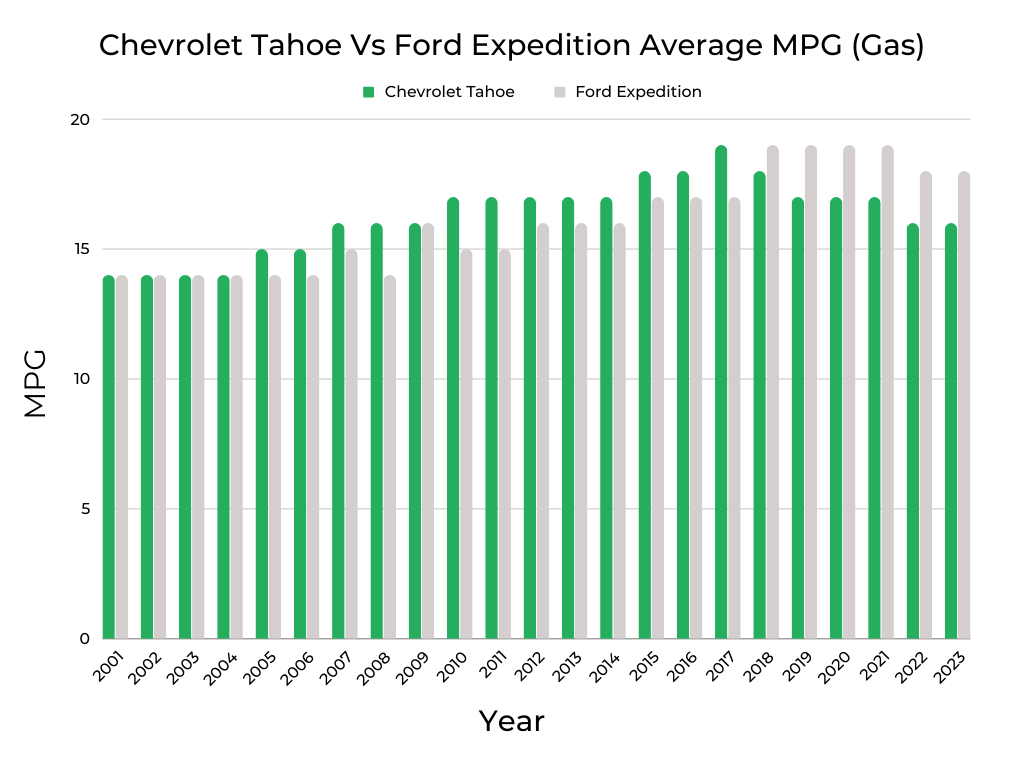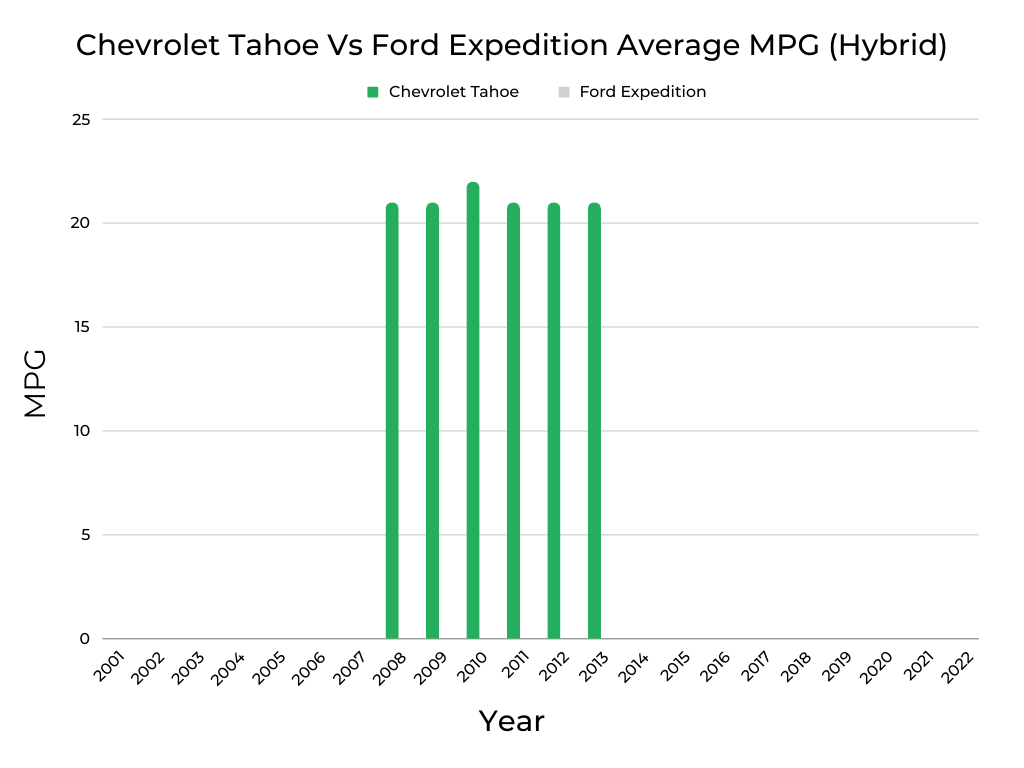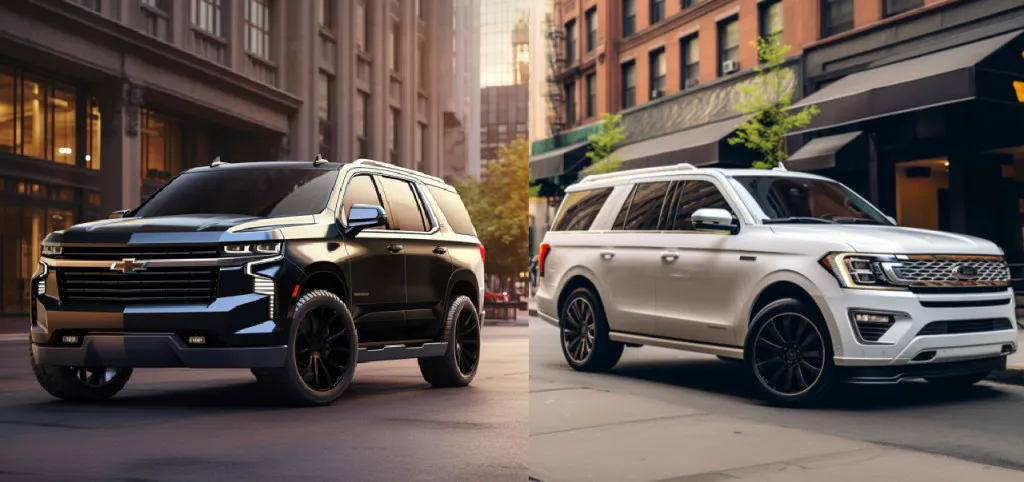| Income Bracket | Monthly Financing Cost Range | Cash Purchase Price Range | Chevrolet Tahoe Years | Ford Expedition Years | Best Model Year: | Why? |
| < $5k | $42 – $83 | $1.5k -$3k | N/A | N/A | N/A | There are no options in this price range |
| $5k – $10k | $83 – $125 | $3k – $4.5k | 2006 | N/A | 2006 Tahoe | Only “worst of” Expeditions are available here |
| $10k – $15k | $125 – $187 | $4.5k – $6.75k | 2011 | 2009, 2010 | 2011 Tahoe | Significantly better FIXD Reliability Score |
| $15k – $25k | $187 – $312 | $6.75k – $11.3k | 2013 | 2016 | 2013 Tahoe | Tahoe offered as a hybrid this year |
| $25k – $35k | $312 – $437 | $11.3k – $15.7k | N/A | 2015 | 2015 Expedition | The only option in this price range |
| $35k – $50k | $437 – $625 | $15.75k-$22.5k | N/A | 2017 | 2017 Expedition | Only “worst of” Tahoe model year available for this price range |
| $50k – $75k | $625 – $925 | $22,5k – $33.3k | 2016-2020 | 2018 | 2019 Tahoe | Perfect 10/10 FIXD Reliability Score |
| $75k-$100k | $925-$1,238 | $33.3k -$44.5k | N/A | 2019 | 2019 Expedition | No Tahoe model years at this price point |
| $100k-$150k | $1,238-$2,250 | $44.55k-$67.5k | 2021 | 2021 | 2021 Expedition | The Expedition is more reliable |
See the methodology for the table above.
These days, roads in the USA are jam-packed with SUVs of every variety. However, back in the mid-1990s, this segment was just getting started and two early entrants – the Chevrolet Tahoe and Ford Expedition – would go on to serious success.
The Tahoe arrived first, in 1992, followed by the Expedition in 1997. At the time, they were little more than pickup trucks with permanent cargo caps. However, over the following 30-plus years, both of these behemoths would evolve into luxurious people movers and become even larger.
Today, the Chevy Tahoe and Ford Expedition are two of the prime candidates for anyone whose vehicular requirements include hauling lots of people and cargo, towing big heavy things, and getting off the beaten path with a true 4×4 drivetrain.
But new models of these flagship SUVs start in the $50,000 to $55,000 range and go way up from there. This is where the used market – and this comparison of the Chevy Tahoe and Ford Expedition – come into play.
This comparison is for folks looking to avoid depreciation while still enjoying the abilities of these full-size SUVs. As you’ll see below, we’ll be comparing the Tahoe and Expedition as far back as 2001 and as recently as 2021.
To do so, we’ll be leaning on the best and worst model year rankings that we’ve already crafted for the Chevy Tahoe and Ford Expedition. These rankings center on objective reliability data pulled from the thousands of FIXD devices installed in owners’ SUVs.
Other factors include safety scores from the National Highway Traffic Safety Administration (NHTSA), current market values from Kelley Blue Book (KBB), fuel economy figures published on FuelEconomy.gov, and owner-reported annual upkeep costs.
Of course, no used car buying journey is started without a budget in mind, which is where the table at the top of the page comes in. The rows are segmented into ranges for income, financing costs, and purchase prices per KBB. The final 3 columns offer Tahoes and Expeditions that have already been rated “best of” in our model year rankings.
As you move through this process, be sure to read through our used car buying checklist. You might also want to look at true competitors like the Toyota Sequoia and competitors from the same corporate parent like the GMC Yukon, Cadillac Escalade, Chevy Suburban, and Lincoln Navigator.
Price History Comparison | Chevrolet Tahoe vs Ford Expedition
Average Market Value – Based on Owners’ Self-Reported Mileages | Chevrolet Tahoe vs Ford Expedition
The chart above plots current market values, according to KBB for the Chevy Tahoe vs. Ford Expedition between 2001 and 2021. We start here to give buyers an idea of how far their budget will stretch based on model year.
Like with most vehicles, as the years wear on, the mileage piles up. This leads to lower values, but as you can see above, the Expedition generally ends up with lower values than a Tahoe of the same vintage. Aside from 2014, 2018, and 2019, the Chevy will cost you more than the Ford.
This ability of the Tahoe to hold its resale value better than the Expedition correlates with the depreciation curves below. Compared to the big Ford, the Chevy’s rate of depreciation is slower as we’ll look at it in more detail shortly.
Notable outliers above include 2015, 2016, and 2020, where the Tahoe commands a relatively huge premium over the Expedition. In all 3 cases, this can be partly chalked up to mileage. According to owners of these model years, the Ford averaged 25,000 miles – or more – than the Chevy each year.
But is it worth paying more for the Chevy? From a reliability perspective, the answer is mostly a yes as we discuss in our model year rankings series for the Tahoe and Expedition. Keep reading to find out how we apply a host of other factors to this decision.
Depreciation vs Maintenance Expenses
These two graphs above build on the resale value discussion from earlier. On the left, the Chevy Tahoe depreciation curve (gray line) has a shallower rate of decline versus the Ford Expedition depreciation curve on the right. Looking closely, we can see for example that the Ford lost 50% of its value 1 year earlier than the Chevy.
This is in line with most any vehicle as depreciation tends to take a 10-15% bite out of residual values after the first year of ownership and upwards of 50% after 5 years. It just takes that bite out of the Expedition sooner than the Tahoe.
For anyone shopping in the used market, this offers an opportunity to save some money. But you want to make sure not to let depreciation inhale too much value as you could end up with an SUV that has little life left in it and lots of big repair bills.
To help you navigate this aspect of buying used, we’ve highlighted “sweet spots” for the Tahoe and Expedition using the black boxes above. These areas show where you can enjoy the benefits of depreciation while keeping maintenance costs per mile in check.
For a used Chevy Tahoe, this zone covers the 2003 through 2010 model years where residual value is less than 10% and maintenance costs per mile are between 5 and 11 cents. Comparing that to the best and worst model years of the Tahoe, we can see that the 2006 Tahoe fits in the sweet spot and is on the right side of the rankings.
Per the Expedition graph, the sweet spot is between 2003 and 2014, a longer stretch than the Tahoe, which means more vehicles to choose from. Within this period, residuals are under 20% and maintenance costs per mile are under 11 cents, and as low as 2 cents.
If you want a used Ford that earns a “best of” nod on our Expedition model year rankings and sits within the depreciation sweet spot, stick with a 2009 or 2010 model year.
Reliability Comparison | Chevrolet Tahoe vs Ford Expedition
When it comes to a used Chevy Tahoe vs Ford Expedition comparison, reliability is a top concern. This is where the two charts above come in. On the left, we have a year-by-year matchup of objective reliability, which is calculated using FIXD device data.
Looking over that chart, we see that the Tahoe bests the Expedition in this metric in 10 out of 21 model years. So, to bolster our comments on an earlier question, it is worth paying more for the Chevy from a reliability perspective nearly 50% of the time.
This is particularly true of the 2006 Chevy, which gets a thumbs up on the Tahoe best and worst model year rankings while earning a 3-point FIXD Reliability Score advantage over the 2006 Ford, which gets a thumbs down on the Expedition model year rankings.
The chart above on the right plots the subjective reliability scores of these two SUVs that are calculated using owner survey responses. In this instance, the Ford outperforms the Chevy with higher scores in 10 of the 21 years. But these figures are based on how reliable owners think their SUVs are so should be taken with a grain of salt.
Longevity Comparison | Chevrolet Tahoe vs Ford Expedition
If you’re wondering what kind of mileage to expect on a used Tahoe or Expedition, the above chart should help. It comes from owner-reported odometer readings over the years and as you might expect, the older the SUV, the higher the mileage.
This is useful for establishing a range of model years with mileage you’re comfortable with. For example, one buyer may happily buy a Tahoe with 200,000 miles all day while another may want to stay under 100,000.
Regardless of which camp you’re in, this chart should put most mileage concerns to rest as both the Chevy Tahoe and Ford Expedition rack it up with ease. The 100,000-mile mark is generally achieved by both as recently as the 2017 model year with the 150,000-mile mark a few years later, and several instances of cracking 200,000 miles.
This speaks to not only the reliability of both SUVs but also how owners use them. As we detail in the best and worst model year series for the Chevy Tahoe and Ford Expedition, owners primarily use their vehicles for family duty and as you can see here, that translates to plenty of road trips.
Who Should Buy These Cars: The Legacy of The Chevrolet Tahoe & Ford Expedition
| Frequent Use Categories: | Chevrolet Tahoe | How Useful? (Out of 5 Stars) | Ford Expedition | How Useful? (Out of 5 Stars) |
| Family Vehicle | **** | **** |
| Lots of Driving (travel/long commute) | *** | *** |
| Hauling/Towing | ** | ** |
| Office on Wheels | * | * |
| Sport/Fast Driving | * | * |
| Luxurious Driving | * | * |
| Outdoor/Off-Road | * | * |
Here is the table backing up my earlier statement on how Chevy Tahoe and Ford Expedition owners primarily use their SUVs. “Family vehicle” ranks the highest in both cases, with 4 out of 5 stars. Along with road trips, this is a testament to the safety of these full-size SUVs.
The “Lots of Driving” category is next up with 3 stars, which correlates with the relatively high mileage readings we discussed earlier. And of course, towing is a key criterion for buying the Tahoe or Expedition, as evidenced by the 2-star rating for this category.
As such, it’s important to do your homework on exactly how the previous owner used their SUV for towing given the extra wear and tear this puts on any vehicle. In particular, you want to make sure they weren’t pulling a trailer heavier than their SUV’s max tow rating.
The same goes for off-roading, which is another common use for these truck-based SUVs. Though both only register 1 star for this category, our data show that between 6 and 7% of Tahoe and Expedition owners use their SUVs to get outdoors, so be sure to do your homework here as well.
Driver Experience | A Summary of The Top 10 Chevrolet Tahoe vs Ford Expedition Reddit Posts:
If it’s unfiltered insight you seek in the discussion of a used Chevy Tahoe vs Ford Expedition, don’t miss the What Car Should I Buy Reddit. It’s here that you can enjoy straight-shooting insight from owners on what they think is your best bet.
I took a look through this colorful forum to get a general sense of what folks think is best and a couple of recurring themes emerged. One is that the Expedition enjoys a reputation for better ride comfort as it went with an independent rear suspension in 2003 versus the Tahoe which only made the switch a few years ago.
Chevy’s 5.3L V8 is well-regarded for being reliable, stout, and cheap to maintain, but Ford’s more recent 3.5L turbocharged V6 powertrain is praised for its smooth power delivery, better fuel efficiency, and higher towing capacity.
But at the end of the day, the Chevy Tahoe and Ford Expedition are very similar in their missions and how they get there. This makes this Redditor comment so on point, “Both are great family haulers and have very long legs. Plus, they are both very reliable. You just need to drive both extensively and pick the one you like the best.”
Year-by-Year Comparison | Chevrolet Tahoe vs Ford Expedition
Best & Worst Years | Chevrolet Tahoe vs Ford Expedition | 2001-2024
 I keep talking about our best and worst model year rankings for the Chevy Tahoe and Ford Expedition. They are packed with data and details, so we’ve condensed the results into the easy-to-digest color-coded graphic above to make your used SUV shopping journey smoother.
I keep talking about our best and worst model year rankings for the Chevy Tahoe and Ford Expedition. They are packed with data and details, so we’ve condensed the results into the easy-to-digest color-coded graphic above to make your used SUV shopping journey smoother.
If a model year falls in the red, it receives a thumbs down in the rankings and is best avoided. The opposite is true of any vehicles in the green. Yellow areas denote model years we don’t yet have enough data collected to make an accurate call.
The blue-circled years mark the start of a new generation. In the auto industry, this is an occasion often accompanied by reliability gremlins as the manufacturer irons out production kinks with the new model. As you can see, the trend rings true with the last three Tahoe generations and the Expedition in 2003 and 2007.
Were you to overlay this graphic with our depreciation sweet spot zones from earlier, you would find the 2006 Chevy Tahoe and 2009-2010 Ford Expedition are in the green and the sweet spot, making them ideal models to consider.
Important Features Timeline | Chevrolet Tahoe vs Ford Expedition
Reliability and budgets are all well and good, but sometimes you just want to know if your SUV has heated seats. The graphic above helps with that by illustrating when popular features were first offered on the Chevy Tahoe and Ford Expedition.
Both have made heated front seats available since at least 2001. Seat ventilation arrived on the Ford a few years later in 2003, but not until 2009 in the Chevy. Apple and Android smartphone mirroring is another must-have feature and one that first appeared in 2019 on both SUVs.
Lately, advanced safety systems have taken center stage in the auto industry, but blind-spot monitoring was available on the Tahoe as far back as 2009 and on the Expedition starting in 2015. This same year the Ford offered lane-departure warning, which the Chevy didn’t make available until 2018.
Given the huge size of the Tahoe and Expedition, it’s nice to know that a backup camera has been offered on both models since 2008 even though the federal government didn’t mandate them until 10 years later.
Other noteworthy features include four-wheel drive, which has been an option on both SUVs since day one. But only the Tahoe has ever offered a more fuel-efficient hybrid powertrain, which was sold between the 2008 and 2013 model years.
Maintenance Costs (Year-by-Year Average) | Chevrolet Tahoe vs Ford Expedition
In this section, comparing the maintenance costs of the Tahoe and Expedition, we can see that although the Chevy ranks higher on reliability most years, you’re going to pay more to keep it that way. These figures come from owner survey responses and are covered in-depth with our best and worst rankings of the Chevy Tahoe and Ford Expedition.
The key takeaway is that the Ford costs, on average over 20 years, $674 in annual repair costs versus $857 for the Chevy. That extra $180 is reflected above as the green Tahoe bars typically exceed the length of the gray Expedition bars.
Another important note here is to look over the previous owner’s service history. If someone was inconsistent with their SUV maintenance and therefore spent less annually than a meticulous owner, this is not necessarily a good thing.
Exceptionally expensive years include the 2002, 2009, and 2014 Tahoe, all of which crack $1,000. Unsurprisingly, they all also received a thumbs down on the model year rankings. The 2007 and 2020 Expedition also have these dubious honors.
The big green sore thumb sprouting up for the 2011 Tahoe marks the only time one of these SUVs blew past the $2,000 mark. But, this Tahoe is actually on the “best of” side of the rankings due to solid reliability among other factors.
Safety Rating Comparison | Chevrolet Tahoe vs Ford Expedition
Safety is an important consideration for any vehicle, but considering the Chevy Tahoe and Ford Expedition are primarily family vehicles, it’s even more so. Fortunately, both of these SUVs have largely rated 4 out of 5 stars in NHTSA testing since 2008.
Before that, the Ford fared better in safety than the Chevy, especially between 2003 and 2005. However, the Expedition took a nosedive on safety in 2011, a year that the NHTSA instituted new stricter testing protocols. It recovered quickly, but this is one reason this model year lands on the wrong side of the Expedition model year rankings.
Fuel Efficiency Comparison | Chevrolet Tahoe vs Ford Expedition

 No one is going to mistake the Chevy Tahoe or Ford Expedition for a hyper-miling Toyota Prius, but that doesn’t mean you should completely ignore the fuel economy figures of these land yachts. Before 2005, it was a pretty pathetic affair with neither SUV capable of hitting 15 mpg on average.
No one is going to mistake the Chevy Tahoe or Ford Expedition for a hyper-miling Toyota Prius, but that doesn’t mean you should completely ignore the fuel economy figures of these land yachts. Before 2005, it was a pretty pathetic affair with neither SUV capable of hitting 15 mpg on average.
But from that point until 2017, the Tahoe mostly edged out the Expedition in the fuel efficiency comparison. It wasn’t until 2018 that Ford took the lead here with the introduction of the latest generation Expedition that brought with it an updated EcoBoost motor, but more importantly a more efficient 10-speed automatic transmission.
If you’re aiming for something a bit cheaper, check out the 2008 through 2013 Chevy Tahoe Hybrid. These models earned upwards of 22 mpg on average with the 2011 and 2013 SUVs also receiving a thumbs up on the Tahoe best and worst model year rankings.
During that stretch, the Ford – which never offered a hybrid powertrain – could only manage between 16 and 17 mpg, but the 2009 and 2010 SUVs are both in the depreciation sweet spot and on the right side of the Expedition’s model year rankings.
Methodology
- Clearly state the purpose of the comparison, which is to compare two vehicles Chevrolet Tahoe vs Ford Expedition, and provide a comprehensive analysis.
- Gather relevant information and data on both vehicles from reliable sources, such as manufacturer specifications, expert reviews, customer feedback, industry reports, and data sources like manufacturer websites, FIXD App, Kelley Blue Book, FuelEconomy.gov, and NHTSA.
- Collect data on various aspects, including performance, safety features, fuel efficiency, maintenance costs, reliability, owner satisfaction, and market value.
- Identify the key criteria that will be used to evaluate and compare the two vehicles.
- Ensure the criteria cover both objective factors (such as performance metrics, safety ratings, and fuel efficiency) and subjective factors (such as owner satisfaction, comfort, and features).
- Examine the safety features and ratings of both vehicles.
- Evaluate crash test ratings, advanced driver assistance systems (ADAS), active and passive safety features, and any notable recalls or known issues related to safety.
- Consider both NHTSA safety ratings and IIHS awards for a comprehensive safety assessment.
- Analyze the fuel economy of both vehicles based on EPA mileage estimates.
- Compare their MPG ratings, average full-tank range, and any significant differences in fuel efficiency.
- Assess the average annual maintenance and repair costs for both vehicles.
- Consider data from surveyed owners and other reliable sources, such as FIXD App owner surveys, to determine the overall cost of ownership over time.
- Evaluate the reliability of both vehicles based on owner reports, FIXD App data, and any known issues or recalls.
- Consider factors such as engine reliability, common problems by model year, long-term durability, and owner reliability scores gathered from surveys.
- Consider owner satisfaction by gathering information from forums, online communities (Reddit: r/whatcarshouldIbuy), customer reviews, and owner reliability scores.
- Summarize key factors that owners appreciate and any common complaints or drawbacks mentioned by owners.
- Compare the features and technologies offered by both vehicles.
- Highlight any notable differences in terms of infotainment systems, connectivity options, driver assistance features, interior quality, and available upgrades.
- Assess the market value and depreciation of both vehicles.
- Compare average prices, resale value, and how the vehicles hold their value over time.
- Consider average private-seller valuations from Kelley Blue Book (KBB) for a comprehensive assessment.
- Summarize the findings of the comparison, highlighting the positives and negatives of each vehicle.
- Provide a fair and balanced recommendation based on the comparison, considering factors such as budget, personal preferences, specific needs of the buyer, and the comprehensive analysis conducted.
Sources:
- KBB Values: Average private-seller valuations as supplied by Kelley Blue Book (KBB), based on a Chevrolet Tahoe and Ford Expedition with typical mileage for that respective model year.
- Fuel Economy: Mileage-per-gallon estimates according to the EPA MPG on Fueleconomy.gov.
- Annual Maintenance/Repairs: Upkeep expenses as reported by surveyed Chevrolet Tahoe and Ford Expedition owners.
- Safety Ratings: Crash test data collected and reported by NHTSA. We average all ratings for each year to come up with a simplified, average safety score. This makes it easier to look at on a graph. We also collected IIHS Awards for this article.
- Vehicle Features: Most or all information gathered on vehicle features were from the manufacturer websites, in this case Chevy.com and Ford.com

Niel Stender grew up doing replacement work on his old Cherokee and sweet Mitsubishi Starion, which led to a degree in mechanical engineering and a job at Ford as a vehicle dynamics engineer. His writing infuses that automotive background with sales and marketing experience. Writing about cars for close to a decade now, he enjoys digging into some of the more technical mechanical systems under the hood and throughout a vehicle.















